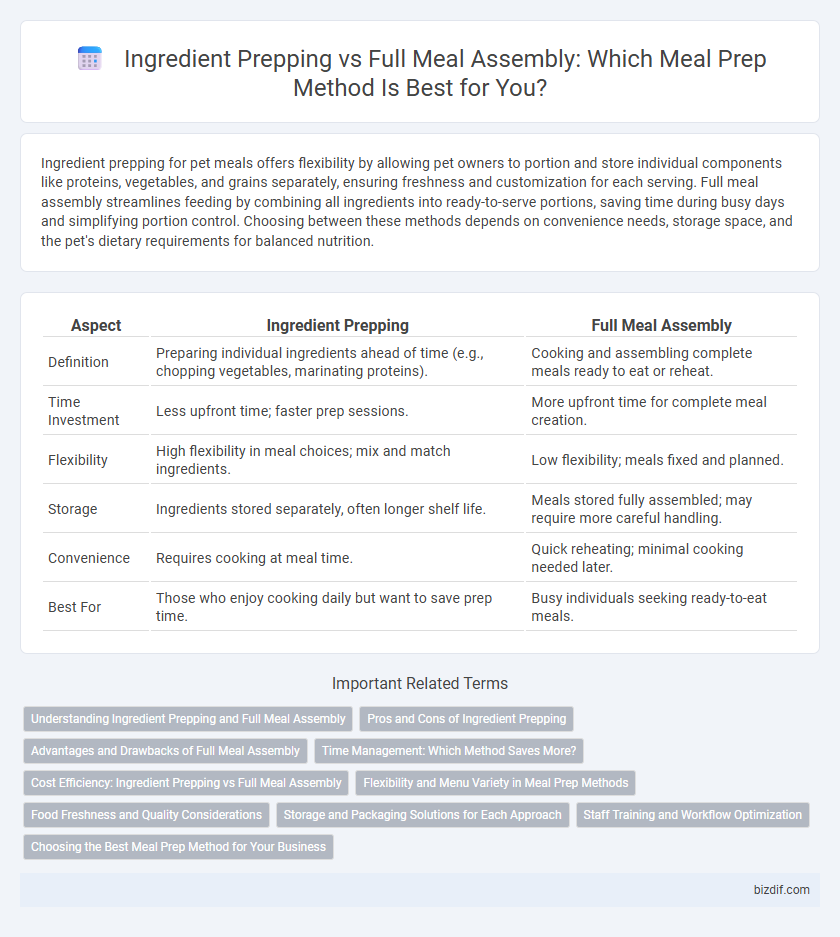Ingredient prepping for pet meals offers flexibility by allowing pet owners to portion and store individual components like proteins, vegetables, and grains separately, ensuring freshness and customization for each serving. Full meal assembly streamlines feeding by combining all ingredients into ready-to-serve portions, saving time during busy days and simplifying portion control. Choosing between these methods depends on convenience needs, storage space, and the pet's dietary requirements for balanced nutrition.
Table of Comparison
| Aspect | Ingredient Prepping | Full Meal Assembly |
|---|---|---|
| Definition | Preparing individual ingredients ahead of time (e.g., chopping vegetables, marinating proteins). | Cooking and assembling complete meals ready to eat or reheat. |
| Time Investment | Less upfront time; faster prep sessions. | More upfront time for complete meal creation. |
| Flexibility | High flexibility in meal choices; mix and match ingredients. | Low flexibility; meals fixed and planned. |
| Storage | Ingredients stored separately, often longer shelf life. | Meals stored fully assembled; may require more careful handling. |
| Convenience | Requires cooking at meal time. | Quick reheating; minimal cooking needed later. |
| Best For | Those who enjoy cooking daily but want to save prep time. | Busy individuals seeking ready-to-eat meals. |
Understanding Ingredient Prepping and Full Meal Assembly
Ingredient prepping involves washing, chopping, and portioning raw ingredients in advance, allowing for flexibility and quicker meal assembly later. Full meal assembly means preparing complete dishes ahead of time, reducing daily cooking effort but requiring more storage space. Understanding the benefits of ingredient prepping versus full meal assembly helps optimize meal planning based on time, convenience, and freshness preferences.
Pros and Cons of Ingredient Prepping
Ingredient prepping offers flexibility by allowing customization of meals throughout the week, reducing food waste and ensuring fresh components. It demands more daily effort and time for combining ingredients during meal times, which may not suit those seeking immediate ready-to-eat options. This method supports healthier eating habits by promoting diverse combinations of vegetables, proteins, and grains tailored to individual preferences and nutritional needs.
Advantages and Drawbacks of Full Meal Assembly
Full meal assembly in meal prepping saves time during busy days by having ready-to-eat portions, reducing daily cooking effort and minimizing decision fatigue. It offers consistent portion control and balanced nutrition but may limit flexibility for varied meal preferences and can lead to quicker food spoilage compared to ingredient prepping. The upfront time investment is higher, and reheating meals might affect texture and flavor compared to freshly prepared dishes.
Time Management: Which Method Saves More?
Ingredient prepping saves more time by breaking down tasks into manageable steps, allowing for flexibility throughout the week and reducing cooking time during busy days. Full meal assembly requires upfront time investment but minimizes daily meal preparation, ideal for those with limited evening availability. Choosing between ingredient prepping and full meal assembly depends on individual schedules and preference for convenience versus flexibility.
Cost Efficiency: Ingredient Prepping vs Full Meal Assembly
Ingredient prepping offers greater cost efficiency by allowing bulk purchasing and reducing food waste through flexible use of versatile ingredients. Full meal assembly can lead to higher upfront costs due to portioned, ready-to-eat meals and less ingredient reuse. Strategic ingredient prepping maximizes budget control by leveraging discounts and minimizing spoilage, essential for long-term meal planning savings.
Flexibility and Menu Variety in Meal Prep Methods
Ingredient prepping offers unmatched flexibility by allowing customization of meals with various combinations of pre-portioned components, catering to diverse dietary preferences and changing schedules. Full meal assembly provides convenience and time savings but may limit menu variety due to fixed portions and complete dish preparations. Balancing ingredient prepping with partial meal assembly strategies enhances both adaptability and efficiency in meal planning.
Food Freshness and Quality Considerations
Ingredient prepping preserves food freshness by allowing components to be stored separately, reducing the risk of sogginess or flavor blending over time. Full meal assembly can enhance convenience but may compromise texture and taste, especially for ingredients prone to wilting or moisture absorption. Prioritizing ingredient prepping optimizes quality retention and extends shelf life for meal preppers focused on fresh, flavorful dishes.
Storage and Packaging Solutions for Each Approach
Ingredient prepping requires versatile airtight containers and portioned storage bags to maintain freshness and prevent cross-contamination, ideal for customizing meals daily. Full meal assembly benefits from stackable, microwave-safe containers that preserve texture and flavor while simplifying grab-and-go convenience. Vacuum-sealed packaging extends shelf life effectively for both methods, supporting meal longevity and minimizing food waste.
Staff Training and Workflow Optimization
Ingredient prepping streamlines staff training by enabling team members to master specific tasks such as chopping, marinating, or portioning, which enhances efficiency and consistency. Full meal assembly requires comprehensive training to ensure proper sequence, timing, and portion control, demanding more advanced skill sets and coordination among staff. Optimizing workflow involves balancing ingredient prepping to reduce downtime with full meal assembly processes that maintain quality and speed during peak service hours.
Choosing the Best Meal Prep Method for Your Business
Ingredient prepping offers flexibility by allowing customization and reducing waste, making it ideal for businesses serving diverse dietary needs or rotating menu items. Full meal assembly streamlines operations by enhancing portion control and speeding up service, which benefits high-volume or fast-casual dining establishments. Evaluating factors such as kitchen capacity, staff expertise, and customer preferences helps determine the most efficient meal prep method tailored to business goals.
Ingredient Prepping vs Full Meal Assembly Infographic

 bizdif.com
bizdif.com